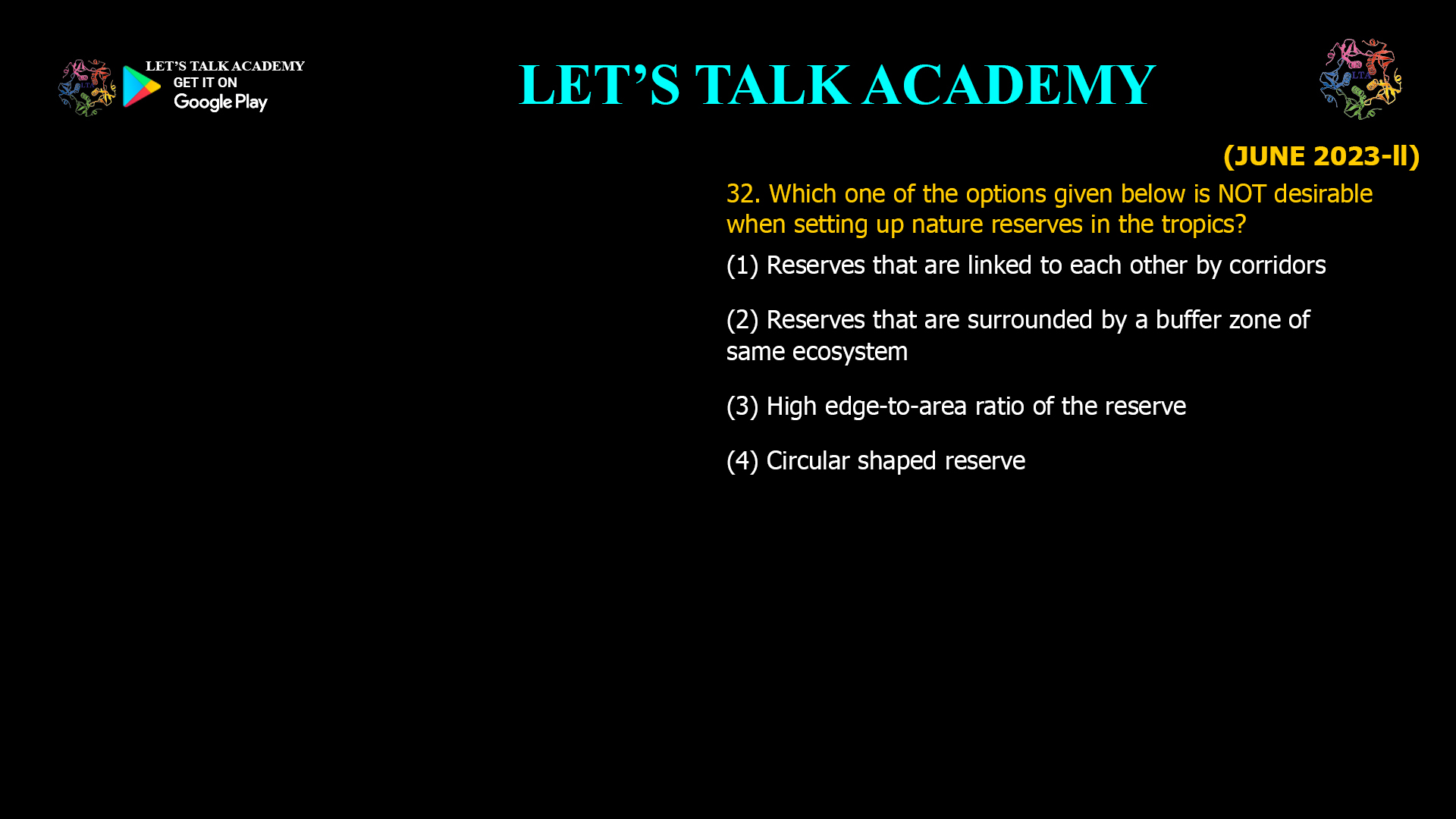- Which one of the options given below is NOT desirable when setting up nature reserves in the tropics?
(1) Reserves that are linked to each other by corridors
(2) Reserves that are surrounded by a buffer zone of same ecosystem
(3) High edge-to-area ratio of the reserve
(4) Circular shaped reserveUnderstanding Edge-to-Area Ratio
The edge-to-area ratio refers to the amount of perimeter (edge) a reserve has compared to its total area. A high edge-to-area ratio means the reserve has a lot of boundary relative to its size, often resulting from elongated or irregular shapes. In contrast, a low edge-to-area ratio is typical of more compact, circular reserves.
Why Is High Edge-to-Area Ratio Undesirable?
A high edge-to-area ratio is not desirable for several reasons:
-
Increased Edge Effects: The edges of a reserve are more exposed to external threats such as invasive species, human encroachment, pollution, and microclimatic changes. These edge effects can penetrate deep into the reserve, degrading habitat quality and threatening sensitive species.
-
Fragmentation: Irregularly shaped or narrow reserves are more likely to be fragmented, making it harder for wildlife to move safely and maintain viable populations.
-
Reduced Core Habitat: The core area—far from the edge—is where the most sensitive species thrive. A high edge-to-area ratio reduces this core, leaving less space for species that require undisturbed conditions.
-
Greater Management Challenges: More edge means more boundary to monitor and protect, increasing the risk of illegal activities and making management more difficult.
Best Practices in Reserve Design
Conservation science and international guidelines recommend the following practices for setting up nature reserves, especially in the tropics:
-
Circular Shaped Reserves: Circular reserves have the lowest edge-to-area ratio, maximizing the protected core and minimizing exposure to edge effects. This shape is universally considered optimal for biodiversity conservation56.
-
Buffer Zones: Surrounding reserves with buffer zones of the same ecosystem helps shield the core from external disturbances and provides a gradual transition for wildlife25.
-
Corridors for Connectivity: Linking reserves with ecological corridors allows for wildlife movement, gene flow, and adaptation to environmental changes. Corridors are essential for maintaining healthy, resilient populations5.
-
Large Size: Bigger reserves are generally better, as they can support more species, larger populations, and intact ecological processes5.
What Should Be Avoided?
When setting up nature reserves in the tropics, it is not desirable to have:
-
High Edge-to-Area Ratio: This increases vulnerability to external threats and reduces the effectiveness of the reserve56.
Desirable Features for Nature Reserves
Let’s look at the options provided:
-
Reserves that are linked to each other by corridors
Desirable. Corridors help maintain genetic diversity and allow species to migrate, adapt, and survive. -
Reserves that are surrounded by a buffer zone of same ecosystem
Desirable. Buffer zones protect the core area from outside disturbances and create a more stable environment. -
High edge-to-area ratio of the reserve
Not desirable. This design increases exposure to edge effects and reduces the effectiveness of the reserve. -
Circular shaped reserve
Desirable. Circular shapes minimize edge and maximize core habitat, making them ideal for conservation56.
Conclusion
When designing nature reserves in the tropics, the goal is to maximize biodiversity protection and ecosystem resilience. This is best achieved by creating large, circular reserves with low edge-to-area ratios, surrounded by buffer zones, and linked by corridors. Avoiding a high edge-to-area ratio is critical, as it exposes the reserve to more threats and diminishes its conservation value. By following these best practices, conservationists can ensure that nature reserves effectively safeguard the world’s most precious and vulnerable ecosystems.
Correct answer:
A high edge-to-area ratio of the reserve is NOT desirable when setting up nature reserves in the tropics. -




2 Comments
Prena Ghangas
October 28, 2025A high edge-to-area ratio of the reserve is NOT desirable
Kajal
November 5, 2025Option 3not desirable